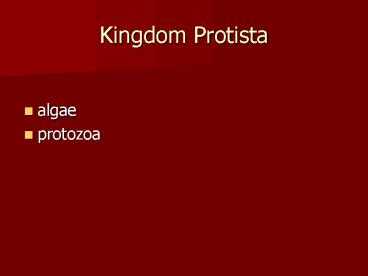Kingdom Protista - PowerPoint PPT Presentation
1 / 17
Title:
Kingdom Protista
Description:
unicellular or multicellular (colonial or filamentous) reproduce sexually and asexually ... e.g. Paramecium. Apicomplexa -non motile -usually intracellular parasites ... – PowerPoint PPT presentation
Number of Views:80
Avg rating:3.0/5.0
Title: Kingdom Protista
1
Kingdom Protista
- algae
- protozoa
2
Algae
- -plant-like protists
- have cellulose walls
- carry out oxygenic photosynthesis using
- chlorophyll a in chloroplasts
- require high moisture
- are photoautotrophs
- unicellular or multicellular (colonial or
filamentous) - reproduce sexually and asexually
3
Algae
4
Algae
- provide basis of food in most aquatic habitats
- produce large proportion of atmospheric O2
- used for cosmetics, food medical products
- classified according to types of pigments cell
wall
5
- Euglenoids (Euglenophycophyta)
- no cell wall pellicle instead
- has flagella and eye spot (animal-like)
- has chlorophyll a (plant-like)
6
- Green algae (Chlorophycophyta)
- -cellulose walls, chlorophyll a
- -flagellated or not
- -food storage as starch
- e.g. Spirogyra sp.
7
- Golden brown algae (Chrysophycophyta)
- light brown pigment chlorophyll a
- cellulose walls
- Flagellated
- food storage as oils
- Special group Diatoms
- - walls of silicon oxide (glass) box lid
- - (diatomaceous earth used for pool filters
and metal polishing)
8
- Brown algae (Phaeophycophyta)
- dark brown pigment chlorophyll a
- cellulose walls
- non motile
- food storage as mannitol
- e.g. Fucus sp.
9
Protozoa
- 65,000 species
- most are unicellular, colonies are rare
- most have locomoter structures flagella, cilia,
or pseudopods - vary in shape
- lack a cell wall chloroplasts
10
- all are heterotrophic,
- most are free-living in a moist habitat
- feed by engulfing other microbes organic matter
- some are animal parasites can be spread by
insect vectors - asexual and sexual reproduction
11
- Life cycle
- - switch between two forms
- 1. trophozoite
- -vegetative state, feeding and
growing - 2. cyst
- -survival state
- -form cyst when conditions bad or
- need to move from one host to next
- (cysts survive stomach acid)
cysts convert back to trophozoite in favorable
conditions (free living ones)
or intestine (parasitic ones)
12
(No Transcript)
13
Classification
- Based on locomotion reproduction
- Mastigophora flagellates
- Sarcodina amebas
- Ciliophora ciliates
- Apicomplexa all parasites motility not well
developed produce unique reproductive structures
14
Mastigophora flagellates
- move via flagella (zooflagellates) e.g.
Giardia (gassy diarrhea) Trypansoma (African
sleeping sickness)
Trichomonas sp.
15
Sarcodina amebas
- move via pseudopods (ameoboid) e.g.
Entamoeba (amoebic dysentery)
16
Ciliophora ciliates
-move via cilia e.g. Paramecium
17
Apicomplexa
-non motile -usually intracellular
parasites -usually transmitted by
insects -usually complex life cycle with
different stages in different hosts e.g.
Plasmodium (malaria)































